

The changing world of work – Shaping the future together. The Future of Work: How You Can Ride the Wave of Change. For the average job-seeker or any parent wondering what kind of livelihood awaits the next generation, the current headlines are the stuff of anxiety attacks.
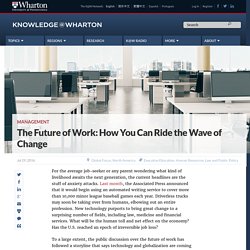
Last month, the Associated Press announced that it would begin using an automated writing service to cover more than 10,000 minor league baseball games each year. Driverless trucks may soon be taking over from humans, elbowing out an entire profession. New technology purports to bring great change to a surprising number of fields, including law, medicine and financial services.
Why Working Multiple Jobs Will Be the New Normal. It’s tempting to think of the rise of the “gig economy” as a nice little bonus for people willing to put in the extra hours to get ahead.
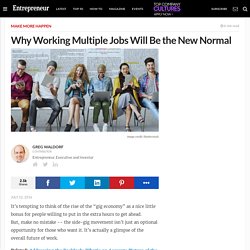
But, make no mistake -- the side-gig movement isn’t just an optional opportunity for those who want it. It’s actually a glimpse of the overall future of work. Related: Addressing the Backlash: What's an Accurate Picture of the Gig Economy? That future is one in which people won’t just have one full-time job with a couple of side hustles. BSR%20 %20LG%20investigates%20the%20FOW. Five ways work will change in the future. 1 | Workplace structures Forget the rigid corporate ladder – now the corporate lattice allows free-flowing ideas and career paths Browse the business section of any bookshop and you’ll find dozens of titles promising to share the secret to climbing the corporate ladder.
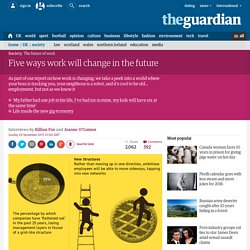
But the day is not far off when such books will seem as quaint and outmoded as a housekeeping manual from the 1950s. One of the key workplace trends of the 21st century has been the collapse of the corporate ladder, whereby loyal employees climbed towards the higher echelons of management one promotion at a time. Cathy Benko, vice-chairman of Deloitte in San Francisco and co-author of The Corporate Lattice, says that the ladder model dates back to the industrial revolution, when successful businesses were built on economies of scale, standardisation and a strict hierarchy. This new diversity, combined with technological advances, has fed demand for a more collaborative and flexible working environment. The Future of Work: 2015 - Free Report. Brought to you by MIT Technology Review publishes bi-monthly reports on the intersection of technology and business.
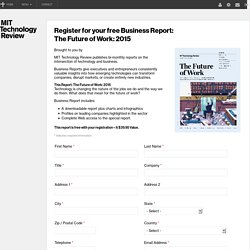
Business Reports give executives and entrepreneurs consistently valuable insights into how emerging technologies can transform companies, disrupt markets, or create entirely new industries. Being Digital II – The workforce of the future. In part one we looked at how business leaders could mitigate digital disruption by pursuing ‘no-risk’ capabilities.
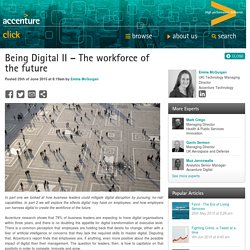
In part 2 we will explore the effects digital may have on employees, and how employers can harness digital to create the workforce of the future. Accenture research shows that 78% of business leaders are expecting to have digital organisations within three years, and there is no doubting the appetite for digital transformation at executive level. There is a common perception that employees are holding back that desire for change, either with a fear of artificial intelligence or concerns that they lack the required skills to master digital. Disputing that, Accenture’s report finds that employees are, if anything, even more positive about the possible impact of digital than their management. The question for leaders, then, is how to capitalize on that positivity in order to compete, innovate and grow. What will the job market look like in 20 years time?
If I was a GCSE student, I hope I wouldn’t be obsessed by what I was going to do when I grew up, says Purcell.
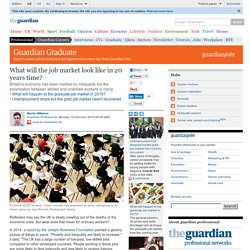
Photograph: Alamy Politicians may say the UK is slowly crawling out of the depths of the economic crisis. But what does that mean for ordinary workers? In 2014, a report by the Joseph Rowntree Foundation painted a gloomy picture of things to come. "Poverty and inequality are likely to increase," it said. Welcome to Forbes. Analysis & opinions. Half a century of growth and modernisation have increased average life expectancy in the Gulf by over 30 years.
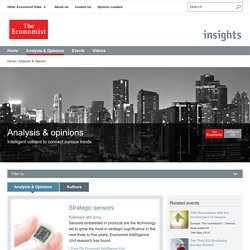
But it has also shifted lifestyle patterns, bringing new health challenges due to poor diet and sedentary lifestyles, with a sharp rise in diabetes, cancer and cardiovascular disease. EIU-Fujitsu%20Working%20in%20the%20Future.pdf. Accenture Technology Vision 2015 - Digital Business Era. The future of jobs: The onrushing wave. IN 1930, when the world was “suffering…from a bad attack of economic pessimism”, John Maynard Keynes wrote a broadly optimistic essay, “Economic Possibilities for our Grandchildren”.

It imagined a middle way between revolution and stagnation that would leave the said grandchildren a great deal richer than their grandparents. But the path was not without dangers. One of the worries Keynes admitted was a “new disease”: “technological unemployment…due to our discovery of means of economising the use of labour outrunning the pace at which we can find new uses for labour.” His readers might not have heard of the problem, he suggested—but they were certain to hear a lot more about it in the years to come. For the most part, they did not. BBC World News - Click, 14/12/2013 GMT, Is this the home and office of 2023? AI, Robotics, and the Future of Jobs.
Key Findings The vast majority of respondents to the 2014 Future of the Internet canvassing anticipate that robotics and artificial intelligence will permeate wide segments of daily life by 2025, with huge implications for a range of industries such as health care, transport and logistics, customer service, and home maintenance.
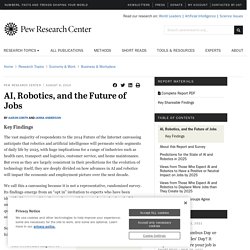
But even as they are largely consistent in their predictions for the evolution of technology itself, they are deeply divided on how advances in AI and robotics will impact the economic and employment picture over the next decade. We call this a canvassing because it is not a representative, randomized survey. Its findings emerge from an “opt in” invitation to experts who have been identified by researching those who are widely quoted as technology builders and analysts and those who have made insightful predictions to our previous queries about the future of the Internet. (For more details, please see the section “About this Report and Survey.”) Experts pledge to rein in AI research. 12 January 2015Last updated at 07:07 ET <div class="warning"><img class="holding" src=" alt="Stephen Hawking" /><p><strong>Please turn on JavaScript.
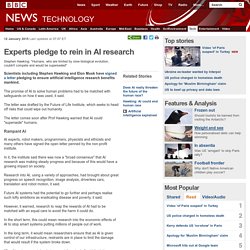
</strong> Media requires JavaScript to play. </p></div> Stephen Hawking: "Humans, who are limited by slow biological evolution, couldn't compete and would be superseded" Scientists including Stephen Hawking and Elon Musk have signed a letter pledging to ensure artificial intelligence research benefits mankind. The promise of AI to solve human problems had to be matched with safeguards on how it was used, it said. Does your leadership team understand the true impact of intelligent technology? Pat Chapman-Pincher posted this on Professor Stephen Hawking believes artificial intelligence could spell the end of the human race.
Others are less pessimistic. Rollo Carpenter, creator of Cleverbot, says: “I believe we will remain in charge of the technology for a decently long time and the potential of it to solve many of the world problems will be realised”. My own view tends more towards Mr Carpenter’s, but I also don’t believe that CEOs or management teams have really understood the impact of software that “solves world problems”.
And particularly not the pace at which this is happening. Here I set out what I see as your future and how boards should manage this rapidly changing landscape. 1. Yes, yes, yes. The Human Impact Of The Industrial Internet Of Things. Editor’s note: Bruno Berthon is the managing director of digital strategy at Accenture. Will digital technology be positive for workers and jobs? Pwc-18th-annual-global-ceo-survey-jan-2015.pdf. Study finds big gaps between student and employer perceptions.
WASHINGTON -- It turns out that college students are being well-prepared for their future careers -- at least in their own minds. Ask employers, and it's a very different picture. 10 Tech Trends That Can Change Our Lives In 2015. As technology changes the way we live our day-to-day lives, it is fascinating to imagine what the coming days will bring. Here’s a list of the top 10 technologies from multiple verticals which are likely to affect and change our lives in 2015 and beyond, states Frost & Sullivan analysts. 1.
Millennial Leaders As the number of graduates increase every year, we expect to see an influx of millennial founders and leaders in the next year, competing with the likes of Pinterest, Airbnb, Facebook, Instagram to name a few. Watch out for more horizontal leadership, collaborative working techniques and new career paths in the next one year, says Frost & Sullivan. 2. Multiple connected devices would allow customers to be less than an arms reach of any virtual information that they need. Genesis%20Report_Exec%20Summary_1029.pdf. Industrial Internet of Things (IIoT) – Accenture. World in beta. Doing business in the Digital Age - Enterprise and Industry. Technology Vision 2014: IT Trends and Innovations. Explore the Technology Vision 2014 digital experience: accenture.com/technologyvision From Digitally Disrupted to Digital Disrupter For business leaders everywhere, the next three years will be devoted to quickening their organizations’ pace in the race to go digital.
Those who take control and move to become disrupters in their markets will emerge as the true, digital world leaders. Big is the Next Big Thing This year’s Technology Vision report continues to expand Accenture’s view of the effects of this digital race—but with one difference: this year, we see more and more large organizations outside of the IT industry actively leading the charge, instead of being pressured by it or taking a fast-follower approach. These organizations understand that, while the digital age is still young, there are many significant opportunities to seize. The future of work – a journey to 2022. What will the workplace of tomorrow look like? - People Management Magazine Online. Social Media at Work How Networking Tools Propel Organizational Performance.
Examples and Resources. EXCLUSIVE: Elizabeth Arden use technology to bring staff together. Elizabeth Arden, the global beauty products business, has revealed how it uses technology to bring its employees together. The company employs 600 beauty consultants that are dedicated to advising and supporting its customers through their beauty purchases. Because Elizabeth Arden operates in concessions within department stores, a lot of its staff are scattered throughout the UK and Ireland with no base. It is for this reason that Elizabeth Arden has now implemented a new HR strategy dedicated to bringing its employees together using technology to create an online platform that all of its employees can utilise.
Sarah Ecoffet, HR Director, Elizabeth Arden, says: “The website is easy to access, from a PC or from any mobile devices. The 10 Most Critical Work Skills in 2020 [Infographic] Talent mobility 2020 and beyond: A global view on talent issues: PwC. Viewpoint: Gartner on the changing nature of work. 10 February 2012Last updated at 00:04 By Tom Austin Vice president, Gartner. Full-time employee jobs account for only one in 40 created since recession. Only one in every 40 new jobs created since the recession has been for a full-time employee, according to the Trades Union Congress. The share of full-time employee jobs – excluding self-employment – fell during the recession and has failed to recover since, falling from 64% in 2008 to 62% in 2014, the TUC said. That is equivalent to a shortfall of 669,000 full-time employees.
Www.successfactors.com/content/dam/successfactors/en_us/resources/white-papers/sap-workforce2020-research-report.pdf. The changing future of jobs: Dennis Stearns at TEDxGreensboro. Infographics - Jobvite. Last year we showed you that a hefty percentage of currently employed workers were actively seeking a new job. This year, that number has become even heftier.
In fact, more than half of those who are employed at present are either actively seeking or open to new job opportunities. And 71% of the U.S. labor force (both employed and unemployed) is on the job market.